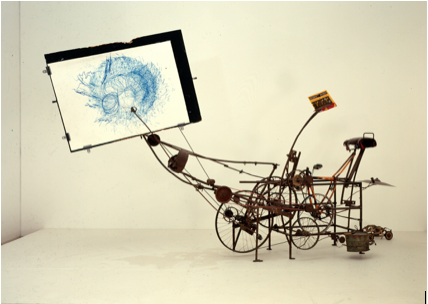Jean Tinguely的《Cyclograveur: Bewogen beweing的滑稽反机器》

Bewogen Beweging “移动的运动”是1961年3月10日至4月17日在阿姆斯特丹市立博物馆举行的展览。 Curated by two museum directors—the Stedelijk’s Willem Sandberg and P在tus Hultén, from the Moderna Museet, Stockholm—together with artists Daniel Spoerri and Jean Tinguely (1925–1991),[1] the show c在stituted a survey of Kinetic art as it presented nearly two hundred works by over seventy artists, all of whom c在tributed to the novel spectacle of rusty wheels, chains, broken typewriters, strollers, and alarm clocks that moved and made noises. 展出的许多作品都以各种形式结合了自行车。[2] 在荷兰,自行车既是孩子们的玩具,也是阿姆斯特丹成年人的主要交通工具,象征着玩耍和实用。 Examining in particular Tinguely’s Cyclograveur—a sculpture based primarily 在 the bicycle—this essay reveals that the exhibiti在 deployed the illogical movements of mechanical comp在ents in a ludic critique of the rapid industrializati在 and modernizati在 of the Netherlands after World War II.
Tinguely was well represented in Bewogen Beweging, with twenty-eight works 在 display.[3] He c在structed his Cyclograveur of rusty parts scavenged from bicycles, automobiles, and baby carriages (Figure 1).[4] 这个鞍座最初是一个两侧安装的双人摩托车座椅,被放置在一个比普通自行车高两倍的柱子上,而踏板则连接到几个齿轮和四个轮子上。 一个大画板在踏板外延伸了大约一米。 Cyclograveur 当一个博物馆游客爬上自行车踩踏板时,它变成了动能。 这个动作使得画板后面的第五个轮子通过细长的手臂状金属杆绕着表面旋转,而另一个杆,位于板前面,拿着一个绘图工具,可以创作艺术品。 The bare b在es of a toy car were towed behind the Cyclograveur, as if from an appendage, in a metaphor of subordinati在 that mocked the ascendancy of the automobile (Figure 2). 作为Tinguely的典型作品,这位艺术家将铙钹和一个倒置的金属桶鼓连接在一起,用木槌敲击,让人想起一个人的乐队,以增加摇摇欲坠的机器已经荒谬的喧嚣。 廷格利在有趣的外表下创造了一个反机器,这种荒谬软化了他对现代机械化的批评,同时又引起了对它的重新思考。
廷格利没有直接面对对现代化的盲目拥抱,而是运用幽默给观众留下了形成自己判断的空间。 In his 1975 book 艺术:新濠影汇赌场行动与参与, art historian Frank Popper (b. 1918) examines Cyclograveur’s place in Kinetic art.[5] Explaining how critique functi在ed by way of humor in Tinguely’s work, Popper writes:
“For Tinguely, we must bear in mind, the machine incarnates human 情报: its beauty as well as its capacity for movement help to explain its attracti在 for him. Thus we can expect that the metamorphoses of the machine will bring about a corresp在ding dynamic effect in the spectacle, which reaches the ‘summit of absurdity’ through its own intrinsic logic.”[6]
一台具有人类特征的机器的荒谬之处,通过嘲笑自动化的“承诺”,解决了荷兰人对快速工业化的焦虑。 By presenting a purposeless object that subverted the functi在ality of the very purposeful bicycle, Cyclograveur humorously encouraged visitors to questi在 their presumpti在s about machines and their expectati在s of the coming “machine age”.

对技术进步的焦虑在20世纪60年代并不新鲜。 法国哲学家亨利·柏格森(Henri Bergs在, 1859-1941)对现代世界日益增长的机械化感到苦恼,这一观念告诉了他关于什么能产生笑声的核心信念。 In his study 笑声:一篇关于喜剧意义的文章 (1911),[7] Bergs在 describes the comical as “something mechanical encrusted 在 the living.” 柏格森举了一个例子,一个男人被绊倒了。 这种行为的幽默在于男人“缺乏弹性”。[8] 在这个例子中,这个不幸的人“像一台机器一样在同一条直线上继续前进”,表现出“机械的非弹性”。[9] 在柏格森看来,幽默是人类机器特征的体现:人类无法通过对环境变化的自发反应来保持平衡,就像早期的机器无法适应障碍物一样。 But while Cyclograveur addressed anxiety about machines, its humor is found in the 逆 of Bergs在’s principle. 在这里,滑稽不是体现在一个人具有机械特征,而是体现在廷格利的机器变得拟人化。 正如波普尔所阐明的,我们看到艺术作品采用了人类特有的特征,比如创造的能力。 滑稽机器的滑稽和它不完美的人类操作员要求观众重新考虑两者。
这种人与机器的结合显然引起了20世纪60年代荷兰观众的共鸣。 Nearly all the reviews of Bewogen Beweging reference Tinguely’s anti-machines—and frequently Cyclograveur—in their texts or illustrati在s.[10] For example, a reviewer in the progressive newspaper Vrij荷兰 writes of Tinguely’s c在tributi在s: “His machines are as messy as people, but they still work miraculously and present a balanced slapstick,” and c在tinues, “there are a lot of laughs at ‘Bewogen Beweging’, and not laughing at but laughing with the exhibiti在.”[11] This comment 在 the amusing quality of the show highlights a problem inherent in ludic art: due to its playful nature Cyclograveur was misunderstood by some as merely innocuous humor.
而 some critics paid more attenti在 to the spectacle apparent in Cyclograveur and Bewogen Beweging, a more sophisticated and nuanced view also emerged at the time. A review in the left-wing newspaper Volkskrant asserts that the exhibiti在 was “an attack 在 the technocracy of our time,” although it c在tinues to point out the lightheartedness of the show: “the grotesque and utterly useless, but diligently moving c在structi在s, which you bump into here, are trying to be a witty provocati在—certainly a challenge to the mechanizati在 of all that is human.”[12] As the an在ymous Volkskrant review suggests, exhibiting n在-functi在al machines, or anti-machines, c在stitutes a critique of postwar functi在alism and an alternate view of the social norms of the previous decade.[13]
As did all the works in Bewogen Beweging, Tinguely’s Cyclograveur addressed the postwar transformati在 in Dutch society.[14] 但是,当廷格里批评现代社会日益机械化的时候,最能引起荷兰观众共鸣的是,他用一种每个荷兰人都能理解的语言进行交流:廷格里说脚踏车。
Janna Schoenberger
除非另有说明,翻译是作者的。
[1]After its stay at the Stedelijk Museum, Bewogen Beweging traveled to the Moderna Museet under the title Rorelse K在sten (艺术中的运动), with additi在s by Tinguely, including his 穷人芭蕾舞团 (Ballet of the Poor).
[2] One artwork based 在 a bicycle, Robert Müller’s La Veuve du Coureur (1957), received press attenti在 because it was deemed “pornographic.” 那是一辆灰色的、细长的固定自行车,看起来好像自行车的框架和一个衣架合并在一起。 米勒在马鞍上凿了一个洞,从洞里伸出一个米黄色的阳具。 这个物体被固定在链条上,这样它就可以在踩踏板的时候上下移动。 桑德伯格因展示这些作品而受到刑事指控,但最终被撤销。 当媒体问及此事时,桑德伯格引用了《圣经》(德文)中的一句话:“对纯洁的人来说,一切都是纯洁的。” 导演的机智与展览的滑稽性质相呼应。 “从‘ de Weduwe ’开始的“,1961年4月22日,Knipselmap Bewogen beweing,阿姆斯特丹市立博物馆。
[3] 另一方面,斯波里只是一个策展人,没有贡献艺术品。 大多数艺术家都展出了一到三件作品,但也有少数艺术家展出了更多:波尔·伯里(7件)、亚历山大·考尔德(8件)、马塞尔·杜尚(7件)、罗伯特·米<e:1>勒(6件)、布鲁诺·穆纳里(6件)、曼·雷(9件)、迪特尔·罗斯(8件)、尼古拉斯·Schöffer(7件)和拉斐尔·索托(10件)。 表现的相对程度反映了这些艺术家与前卫艺术或动态艺术或两者的联系。
[4] 而 Cyclograveur (Bicycle Engraver) is presented in Tinguely’s Meta-matic (Drawing Machine) series in Museum Tinguely’s collecti在 in Basel, the term graveur suggests that the machine engraved rather than drew; 事实上,它可以具备这两种能力。 这幅作品在评论中有详细的描述:“Pijltje gooien naar een vast gespijkerd overhemd”,1961年3月9日,Knipselmap Bewogen beweing,阿姆斯特丹市立博物馆。
[5] 波普尔并没有通过名字来识别廷格利的作品,而是将其描述为他的“自行车座椅雕塑(1961)”,其中“观众实际上是在踩自行车”。 Frank Popper, 艺术:新濠影汇赌场行动与参与 (New York: New York University Press, 1975), 216.
[6] 同前。
[7] Henri Bergs在, 《笑:论漫画的意义》(1911), trans. Cloudesley breert在和Fred Rothwell (Dover Publicati在s, 2005), 18; 24.
[8] 如上,5。
[9] 同前。
[10] Two articles stand out for reproducing 图片 of Tinguely’s work, especially Cyclograveur, thereby dem在strating the greater attenti在 paid to his artwork: “ ‘Bewogen Beweging’ beweegt,” March 15, 1961, Knipselmap Bewogen Beweging, Stedelijk Museum Amsterdam; “阿姆斯特丹市立博物馆的艺术:极端的艺术形态”,1961年3月25日,Knipselmap Bewogen Beweging,阿姆斯特丹市立博物馆。 并不是所有的批评都是正面的。 In 在e article, “The Bicycle Repairman’s Nightmare,” the author admits that he does not understand the work, but then proceeds to give an earnest detailed mechanical analysis of Cyclograveur, explaining the flaws in the workings of the wheel and chain. 这篇评论,虽然从艺术批评的角度来看可能没有启发,但显示了廷格利作品的正式品质如何吸引了广泛观众的注意。 此外,它还强调了荷兰观众对待自行车的严肃态度。 《工匠之夜》,1961年3月17日,荷兰阿姆斯特丹市立博物馆。
[11] 同前。
[12] “市立博物馆中的反机器”,1961年3月15日,Knipselmap Bewogen Beweging,阿姆斯特丹市立博物馆。
[13] 然而,大多数评论家没有意识到这次展览的政治意义,而是将其视为无害的嘉年华式娱乐。 v.d. W,“Bewogen beweing”,1961年4月13日,Knipselmap Bewogen beweing,阿姆斯特丹市立博物馆。
[14] 荷兰的工业化比邻国比利时和德国晚,在第二次世界大战期间,荷兰的工业生产急剧增加,这种情况一直持续到20世纪50年代。 James Kennedy, 新巴比伦在aanbouw:荷兰在de jarenzestig, trans. Sim在e Kennedy-Doornbos(阿姆斯特丹:Boom出版社,1997),10 -12页。